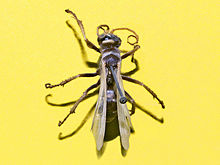| Batozonellus lacerticida | |
|---|---|

| |
| Batozonellus lacerticida. Museum specimen | |
| Scientific classification | |
| Kingdom: | |
| Phylum: | |
| Class: | |
| Order: | |
| Suborder: | |
| Superfamily: | |
| Family: | |
| Subfamily: | |
| Genus: | |
| Species: | B. lacerticida
|
| Binomial name | |
| Batozonellus lacerticida (
Pallas, 1771)
| |
Batozonellus lacerticida is a species of the spider-hunting wasp of the family Pompilidae. [1]
Description
Batozonellus lacerticida can reach a length of about 14 millimetres (0.55 in). [2] These spider hunting wasps have a mainly black body, with yellow markings on the abdomen. Wings are orange, with a brownish band on the tips of the forewings. [3]
Biology
This species hunts large orb weaver spiders (family Araneidae), mainly Argiope bruennichii, Argiope lobata, Araneus angulatus and Araneus ventricosus. The wasps paralyze these spiders with their poisonous stings and drag them into their underground nests. Then they lay an egg into the abdomen of their prey. [3] [4]
Distribution
This species can be found in most of Europe. [5]
References
External links
- Batozonellus lacerticida - Biodiversity Heritage Library - Bibliography
- Batozonellus lacerticida - NCBI Taxonomy Database
- Batozonellus lacerticida - Global Biodiversity Information Facility
- Batozonellus lacerticida - Encyclopedia of Life
| Batozonellus lacerticida | |
|---|---|

| |
| Batozonellus lacerticida. Museum specimen | |
| Scientific classification | |
| Kingdom: | |
| Phylum: | |
| Class: | |
| Order: | |
| Suborder: | |
| Superfamily: | |
| Family: | |
| Subfamily: | |
| Genus: | |
| Species: | B. lacerticida
|
| Binomial name | |
| Batozonellus lacerticida (
Pallas, 1771)
| |
Batozonellus lacerticida is a species of the spider-hunting wasp of the family Pompilidae. [1]
Description
Batozonellus lacerticida can reach a length of about 14 millimetres (0.55 in). [2] These spider hunting wasps have a mainly black body, with yellow markings on the abdomen. Wings are orange, with a brownish band on the tips of the forewings. [3]
Biology
This species hunts large orb weaver spiders (family Araneidae), mainly Argiope bruennichii, Argiope lobata, Araneus angulatus and Araneus ventricosus. The wasps paralyze these spiders with their poisonous stings and drag them into their underground nests. Then they lay an egg into the abdomen of their prey. [3] [4]
Distribution
This species can be found in most of Europe. [5]
References
External links
- Batozonellus lacerticida - Biodiversity Heritage Library - Bibliography
- Batozonellus lacerticida - NCBI Taxonomy Database
- Batozonellus lacerticida - Global Biodiversity Information Facility
- Batozonellus lacerticida - Encyclopedia of Life